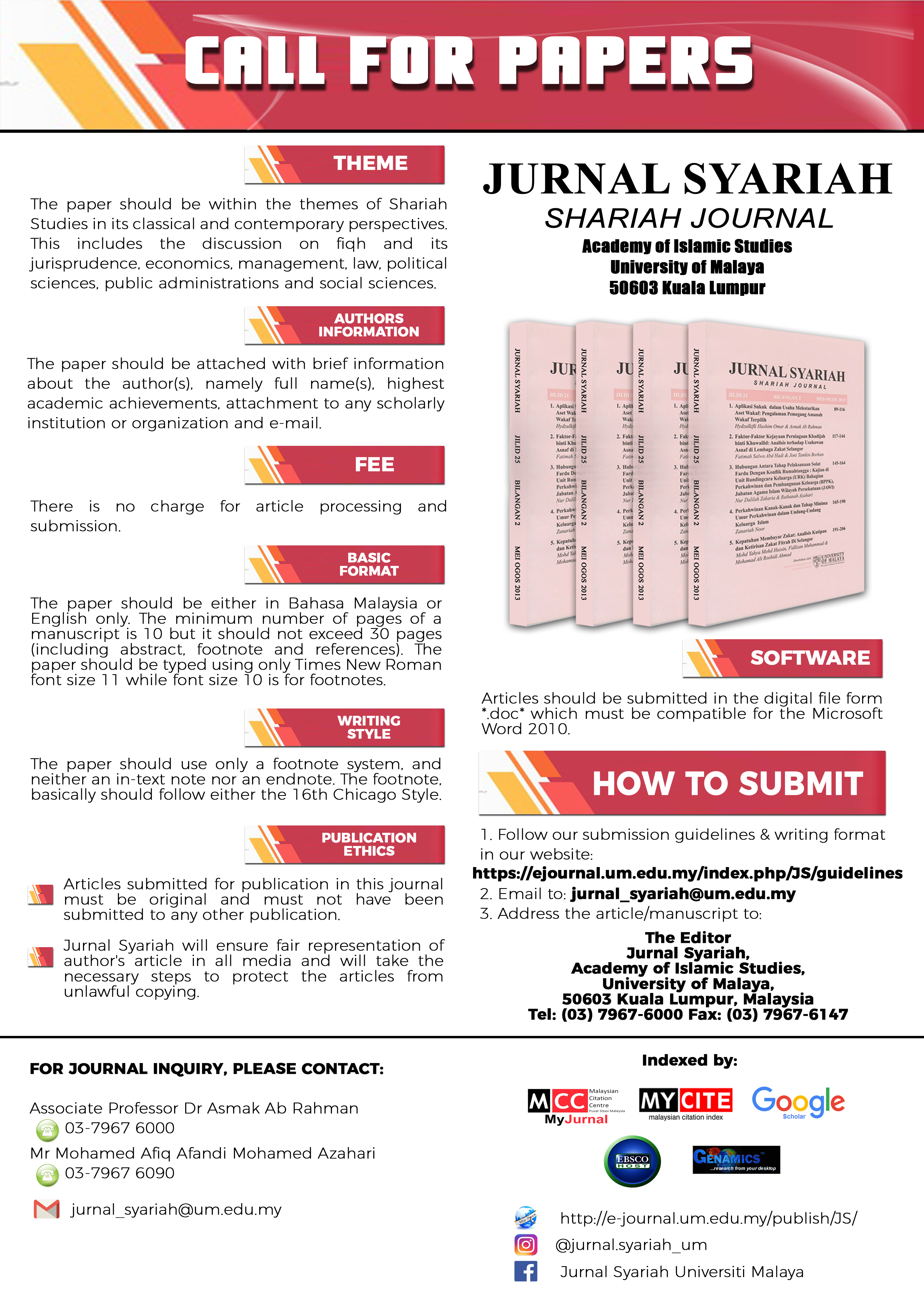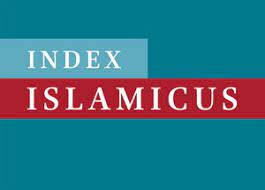PRINSIP PERHUBUNGAN AWAM MENURUT PERSPEKTIF ISLAM: PENELITIAN KONSEPTUAL
Principles of Public Relations Based on the Islamic Perspective: Conceptual Research
DOI:
https://doi.org/10.22452/js.vol29no2.7Keywords:
Principles, Public Relations, IslamAbstract
Public relations are one of the essential elements for most of the organisations today. It is a center of focus in the organisations for channeling and disseminating the information both internally and internationally. Usually, public relations unit is the entity that responsible and directly involved in the public relations process. However, in the absence of a dedicated public relations unit, other people or units play a role in carrying out public relations responsibilities. In fact, most of the organisations use public relations to handle current issues or difficulties. Besides, it is used as one of the channels to publicize the achievements and successes achieved by the organisations. While conducting public relations, it might cause several issues such as non-transparency, interruption and inconsistencies. These should be avoided because they are not only destroying the social norms but also religious norms. Thus, this article will explain the fundamentals of Islamic public relations. Data are gathered through library study, as well as research on the Qur’an, Sunnah, and history. Next, it will be analysed using content analysis. Based on the findings, there are five elements of Islamic public relations: (1) create understanding, (2) protect the truth, (3) honor the promises, (4) use acceptable language and (5) take appropriate approach. The outcomes of this research will contribute to the development of knowledge in the field of public relations in general and Islamic public relations in particular.
Downloads
References
ʿAbd al-Karīm Zaydān, al-Wajīz fī Uṣūl al-Fiqh (Bayrūt: Mu’asasah al-Risālah, 1987).
ʿAbd al-Wahhāb Khalāf, ʿllm Uṣūl al-Fiqh (Bayrūt: Dār al-Qalam, 1986).
Al-ʿAsqalānī, Fatḥ al-Bārī, (Jakarta: Pustaka ‘Azzam, 2011).
Abdullah Hassan, Bahasa Melayu Sebagai Bahasa Ilmu dan Esei-Esei Lain (Shah Alam: Penerbit Fajar Bakti, 1997).
Adib Imran, Warkah Lama Pengungkap Peradaban Bangsa (Kuala Lumpur: Dewan Bahasa dan Pustaka, 1999).
Ahmad Atabik, ‘Teori Kebenaran Perspektif Filsafat Ilmu’, Fikrah, vol. 2/1 (2014): 253-271.
Ahmad Hidayat Buang, Nazri Muslim dan Nik Yusri Musa, ‘Hubungan Etnik di Malaysia dari Perspektif Islam’, Kajian Malaysia, vol. 29/1 (2011): 1-28.
Aḥmad Zakī Manṣūr Ḥammād, ‘Abu Hamid Al-Ghazali’s Juristic Doctrine,’ dalam al-Muṣṭafa min ʿilm al-Uṣūl: With a Translation of Volume One of al-Muṣṭafa min ʿilm al-Uṣūl’ (Chicago: The University of Chicago, 1987).
Aminudin Basir, Mohd Radzi Othman & Nik Yusri Musa, ‘Konsep Al-Sunnah Menurut Ahli Hadith’, Jurnal Pengajian Umum Asia Tenggara, vol. 8 (2006): 1-22.
Annabel Teh Gallop, Art of the Malay Letter, ed. E. Ulrich Katz (London: British Library Publishing, 1994).
Azneal Ishak, ‘Ismail Sabri Defends Flip-Flop SOPs Following Public Outrage’, Malaysiakini, https://www.malaysiakini.com/news/574302, dicapai pada 19 Mei 2021.
Al-Bayhaqī, al-Jāmiʿ Shaʿb al-Īmān (Riyāḍ: Maktabah al-Rashād, 2003).
Al-Bukhārī, Ṣaḥīḥ al-Bukhārī (Bayrūt: Dār Ibn Kathīr, 2002).
Dennis L. Wilcox, Glen T. Cameron dan Bryan H. Reber, Public Relations: Strategies and Tactics, 11th edn (New York: Pearson Education Inc, 2015).
Ekhwan Haque Fazlul Haque, ‘SOP Tahun Baru Cina Hasil Persetujuan dengan 21 Pertubuhan Agama Berkaitan’, MyMetro, <https://www.hmetro.com.my/mutakhir/2021/02/671619/sop-tahun-baru-cina-hasil-persetujuan-dengan-21-pertubuhan-agama-berkaitan>, dicapai pada 18 Mei 2021.
Hafid Muhyiddin Baehaqi, ‘Janji Antar Manusia dalam Al-Quran’ (Disertasi Sarjana, Fakultas Ushuluddin dan Dakwah, Institut Agama Islam Negeri (IAIN) Ponorogo, 2020).
Halimatus Sakdiah, ‘Komunikasi Interpersonal Sebagai Strategi Dakwah Rasulullah’, Alhadharah Jurnal Ilmu Dakwah, vol. 15/30 (2016): 39-51.
Imron Mustofa, ‘Konsep Kebenaran Ibnu Sina’, Kalimah: Jurnal Studi Agama dan Pemikiran Islam, vol. 15/1 (2017): 1-18.
James E. Grunig & Fred C. Repper, ‘Strategic Management, Publics and Issues’, dalam Excellence in Public Relations and Communication Management, ed. James E. Grunig (New Jersey: Lawrence Erlbaum, 1992), 109-114.
James E. Grunig dan Larissa A. Grunig, Guidelines for Formative and Evaluative Research in Public Affairs (Maryland: University of Maryland, 2001).
Jawih Dakir, ‘Ulasan Buku: Sains, Masyarakat dan Agama’, Jurnal Hadhari, vol. 3/1 (2011): 93-99.
Jelani Harun, Pemikiran Adab Ketatanegaraan Kesultanan Melayu (Kuala Lumpur: Dewan Bahasa dan Pustaka, 2003).
Kamarul Azmi Jasmi dan ’Atiqah Selamat, ‘Al-Quran Satu Mukjizat Yang Menakjubkan’, dalam Penciptaan Manusia Dari Perspektif Al-Quran, ed. Kamarul Azmi Jasmi (Skudai: Penerbit UTM Press, 2013).
Kamus Dewan, 4th ed. (Kuala Lumpur: Dewan Bahasa dan Pustaka, 2005).
Kevin Moloney, Rethinking Public Relations: PR Propaganda and Democracy, 2nd edn (Oxfordshire: Routledge, 2006).
Khairul Azhar Meerangi, Ahmad Faqih Ibrahim dan Muhammad Hilmi Mat Johar, ‘Prinsip Asas Interaksi Inter-Agama Menurut Perspektif Islam’, Kolokium Penyelidikan Kebangsaan (Masjid Tanah: Kolej Universiti Islam Melaka, 2018), 872-885.
Lothrop Stoddard, The New World of Islam (London: Chapman and Hall Ltd, 1922).
Manṣūr ʿUṯhmān Muḥammad Zīn, al-Manẓūr al-Islāmī lil Ālāqāt al-ʿĀmah (Omdurman, Sūdān: Omdurman Islamic University, 2008).
Martin Heidegger, Pathmarks, ed. William McNeill (Cambridge: Cambridge University Press, 1998).
Md Shahidul Haque dan Jamilah Ahmad, ‘The Role of Islamic Public Relations in Leadership’, International Conference on Islamic Leadership and Management (ICILM 2016) (Bandar Seri Begawan: Universiti Islam Sultan Sharif Ali, 2016), 252–264.
Michael H. Hart, The 100: A Ranking of the Most Influential Persons in History, 2nd edn (New York: Hart Publishing Company, 1992).
Moenawar Chalil, Kelengkapan Tarikh Nabi Muhammad II. (Jakarta: Gema Insani, 2001).
Mohamed Kirat, ‘The Islamic Roots of Modern Public Relations and Corporate Social Responsibility’, International Journal of Islamic Marketing and Branding, vol. 1/1 (2015): 97-112.
Mohd Faizal Kamsani, Nurul Asiah Fasehah Muhamad, Rozita Abdullah, Norjihan Jaafar dan Nor Zulaili Mohd Ghazali, ‘Tindak Tutur Perbualan Bersama Golongan Badwi dan Ansar: Analisa Strategi Komunikasi Rasulullah’, Jurnal Komunikasi, vol. 35/3 (2019): 334-352.
Mohd Yusof Othman, Penghayatan Sains Melalui Al-Quran, Seminar Al-Quran, (Pulau Pinang: Jabatan Mufti Negeri Pulau Pinang, 2012).
Mokhtarrudin Ahmad, ‘Amalan Perhubungan Awam: Kajian Terhadap Kecemerlangan dan Amalan Perhubungan Awam di Organisasi Tersenarai di Bursa Malaysia’ (Tesis Doktor Falsafah, Pusat Pengajian Komunikasi, Universiti Sains Malaysia, Pulau Pinang, 2011).
Muḥammad Abū Zahoū, al-Muḥaddith wa al-Muḥaddithūn (Bayrūt: Dār al-Kitāb al-‘Arabī, 1984).
Muḥammad Saʿīd Ramaḍān al-Būṭī, Fiqh Sīrah al-Nabawiyah (Bayrūt: Dār al-Fikr, 1991).
Mustafa As-Syibaie, Sirah Nabi Muhammad SAW Pengajaran dan Pedoman, terj. Bahagian Penterjemahan dan Suntingan Pustaka Salam Sdn. Bhd. (Rawang: Pustaka Salam, 2010).
Nik Roskiman Abdul Samad, ‘Peranan Media dalam Melestarikan Masyarakat Kasih Sayang’, Prosiding Wacana Keputeraan Sultan Muhammad V (Jeli: Universiti Malaysia Kelantan, 2015), 181-192.
Norafifah Abdul Hamid, ‘Prinsip Islam dan Nilai-Nilai Kemanusiaan,’ dalam Islam dan Hubungan Etnik: Sorotan Sejarah dan Isu Kontemporari di Malaysia, ed. Mohd Faizal P. Rameli (Alor Gajah: Akademi Pengajian Islam Kontemporari UiTM Melaka, 2014), 245-268.
Periasamy Muthan, ‘Peranan dan Amalan Perhubungan Awam di Malaysia: Satu Kajian Kes Terhadap Pegawai Perhubungan Awam Kerajaan’ (Disertasi Sarjana, Pusat Pengajian Komunikasi, Universiti Sains Malaysia, Pulau Pinang, 2007).
Al-Qurṭubī, al-Jāmiʿ li Aḥkām al-Qur’ān, ed. ʿAbd al-Razāq al-Mahdī (Miṣr: Dār al-Maṭābī al-Shab, 1999).
R. Parmono, ‘Nilai dan Norma Masyarakat’, Jurnal Filsafat, vol. 23 (1995): 20-27.
Rex. F. Harlow, ‘Public relations definitions throught the years’, Public Relations Review, vol. 3/1 (1977): 49-63.
Rozita Che Rodi, Salmah Jan Noor Muhammad dan Hashim Musa, ‘Pembinaan Ilmu Diplomatik Melayu dalam Menjalin Hubungan Diplomatik Antara Kerajaan’, Persidangan Antarabangsa Manuskrip Melayu (Kuala Lumpur: Hotel Seri Pacific, 2014).
Sabitha Marican, Kaedah Penyelidikan Sains Sosial (Kuala Lumpur: Pearson Malaysia, 2005).
Saidathul Nizah Mat Tazin & Kiranjit Kaur, ‘Strategic Crisis Communication and Stakeholder Reactions in a Malaysian Government-Linked Company’, Media Asia, vol. 41/1 (2014): 25-30.
Ṣāliḥ ʿIwāḍ, al-Āthār al-ʿUrf fī al-Tashrīʿ al-Islāmī (Miṣr: Dār al-Kitāb al-Jami’, 1969).
Scott M. Cutlip dan Glen M. Broom, Effective Public Relations (New Jersey: Prentice Hall, 2009).
Stephen P. Robbins, Organization Behavior: Concepts, Controvercies and Application, 8th ed. (New Jersey: Prentice Hall, 1998).
Sulvinajayanti, ‘Praktik Public Relation dalam Pandangan Islam’, KOMUNIDA: Media Kamunikasi dan Dakwah, vol. 8/2 (2018): 134-154.
Syed Arabi Idid Syed Abdullah dan Mohd Safar Hasim, Perhubungan Awam di Malaysia: Satu Kajian Tentang Pengamal di Malaysia (Bangi: Universiti Kebangsaan Malaysia, 1995).
Tim P. Vos, ‘Explaining the Origins of Public Relations: Logics of Historical Explanation’, Journal of Public Relations Research, vol. 23/2 (2011): 119-140.
‘Warganet Kecewa Keputusan “Flip Flop” Kerajaan Berkait PKP’, Freemalaysiatoday, https://www.freemalaysiatoday.com/category/ bahasa/tempatan/2021/05/11/warganet-kecewa-keputusan-flip-flop-kerajaan-berkait-pkp/>, dicapai pada 18 Mei 2021.
Yūsuf al-Qaraḍāwī, Kayfa Natʿāmal maʿ al-Sunnah al-Nabawiyyah (Riyāḍ: Maktabah al-Muayyad, 1991).
Zuly Qadir, ‘Mempertimbangkan Metode Integralistik: Sosiologi Untuk Kajian Islam dan Sosial,’ Jurnal Sosiologi Reflektif, vol. 10/2 (2016): 1-14.
Downloads
Published
How to Cite
Issue
Section
License

This work is licensed under a Creative Commons Attribution-NonCommercial 4.0 International License.
COPYRIGHT: All rights reserved. Not allowed to be reproduced any part of articles and contents of this journal in any form or by any way, whether electronic, mechanical, photocopying, recording or otherwise without permission in writing from the Chief Editor, Jurnal Syariah.



















